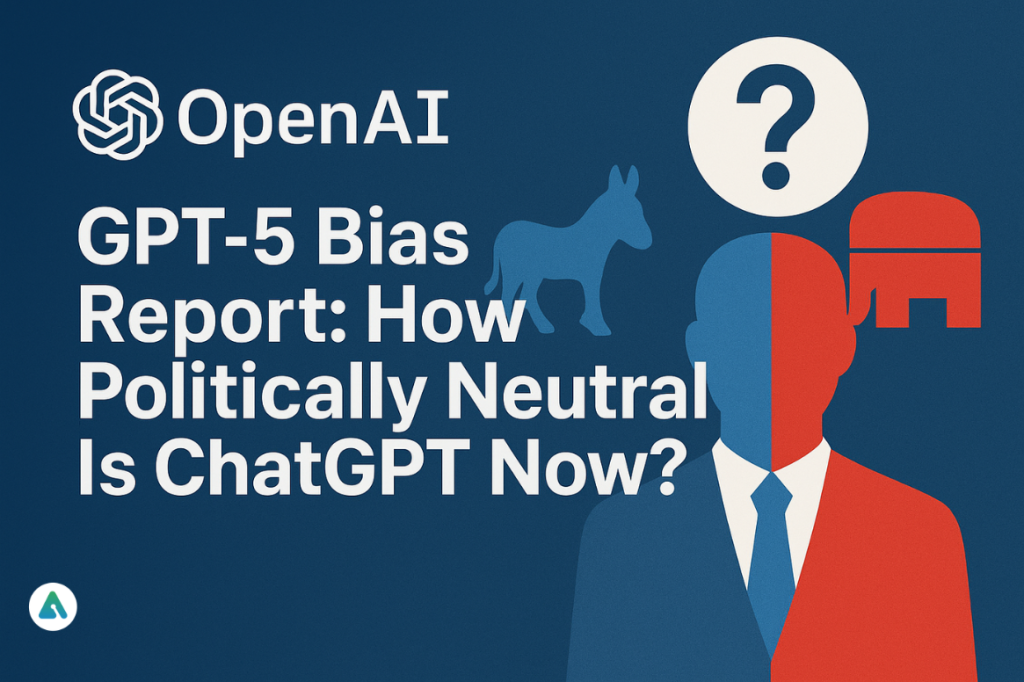OpenAI is taking another swing at one of AI’s toughest challenges: political bias. In a new report released this week, the company claims that its latest generation — GPT-5 Instant and GPT-5 Thinking — show a major drop in political bias compared to previous models like GPT-4o.
According to OpenAI’s internal evaluation, GPT-5 models are now around 30% more politically neutral, marking what the company calls a “significant milestone” in its mission to create objective and fair conversational AI.
How OpenAI Measured Bias
The new study, titled “Defining and Evaluating Political Bias in LLMs,” is OpenAI’s first large-scale attempt to quantify bias using structured prompts that mirror real user interactions.
The researchers tested GPT-5 using over 500 politically themed prompts across 100 different topics — from climate policy to immigration to economic regulation. Each prompt was written from left-leaning, right-leaning, and neutral perspectives to test how the model responds.
Instead of a single “bias score,” OpenAI broke bias down into five categories:
- User invalidation: when the model dismisses a user’s viewpoint.
- User escalation: when it mirrors or amplifies partisan tone.
- Personal political expression: when the AI expresses an opinion as its own.
- Asymmetric coverage: when it spends more time or context on one political side.
- Political refusals: when the model declines to answer political questions without reason.
Across these metrics, GPT-5 models consistently outperformed GPT-4o, especially in avoiding personal or ideological statements. However, OpenAI noted that subtle bias still appeared in emotionally charged or heavily politicized queries — particularly those written from liberal-leaning perspectives.
A 30% Improvement — But Not Perfect
OpenAI claims that less than 0.01% of ChatGPT outputs now show detectable political bias in live production, based on sample monitoring.
That’s a notable improvement from earlier versions — but it’s not bias-free.
The company admits GPT-5 still struggles with “stress tests,” where users push the model toward taking a stance on divisive political or moral issues.
To mitigate that, OpenAI says it’s developing “context-aware alignment” — a system that keeps models neutral without dodging the question entirely, a common complaint from users who felt earlier ChatGPT versions were evasive or moralizing.
Why It Matters Now
This research lands at a politically sensitive time. With global elections approaching and regulators sharpening their focus on “ideological AI,” OpenAI’s push for transparency is as much a PR necessity as a scientific step forward.
Governments and watchdogs have criticized AI companies for producing models that “lean liberal” or reflect Silicon Valley’s social norms. Earlier independent studies found that major chatbots — including GPT-4, Gemini, and Claude — tended to frame political questions more sympathetically toward progressive viewpoints.
OpenAI’s latest report seems designed to counter that narrative, showing measurable progress backed by reproducible metrics. But the company also concedes that “perfect neutrality” may not even be possible — since neutrality itself can be subjective depending on cultural or political context.
Skepticism From the Research Community
While the report has drawn cautious optimism, AI ethicists and political scientists say OpenAI’s self-assessment should be treated carefully.
Some argue that measuring bias through text prompts still misses deeper structural issues — like training data skew, cultural framing, and the human reinforcement patterns used during model fine-tuning.
Others point out that internal tests can’t fully capture how models behave in the wild, especially when millions of users prompt ChatGPT in unpredictable ways.
“There’s no universal definition of neutrality,” says one researcher quoted by Axios. “A model that seems balanced in the U.S. might still show cultural bias elsewhere.”
The Bigger Picture
The AI industry’s race to build “unbiased” models is more than an academic exercise — it’s a regulatory survival strategy. With U.S. and EU policymakers exploring new rules for algorithmic fairness and political transparency, every major lab is now under pressure to prove its systems don’t manipulate users or reinforce partisanship.
For OpenAI, that means building public trust while staying ahead of scrutiny from both sides of the political aisle. By open-sourcing parts of its bias evaluation framework, the company hopes to set a shared industry benchmark — and shift the conversation from “Is ChatGPT biased?” to “How do we measure bias in the first place?”
Bottom Line
OpenAI’s GPT-5 models may indeed be the least biased large language models the company has built — at least according to its own data. But the experiment also underscores a larger truth:
Bias isn’t a bug you can patch once and move on from. It’s a moving target — one that evolves as society, politics, and even our definition of fairness change.
And for AI developers, that means neutrality will never be a finish line. It’ll always be part of the race.
Visit: AIInsightsNews


